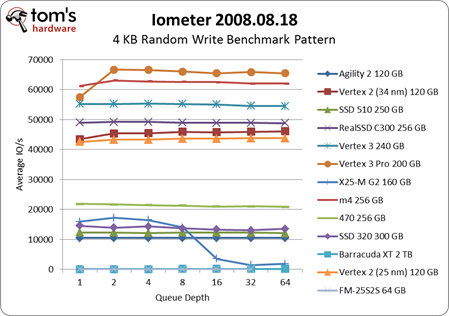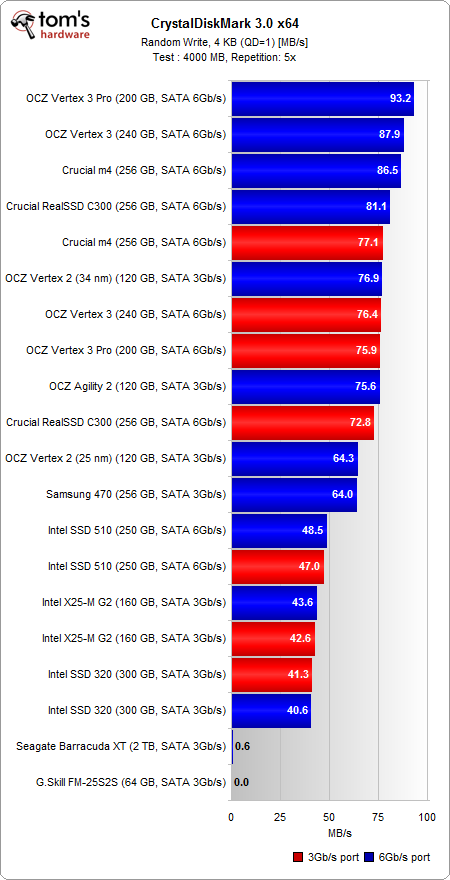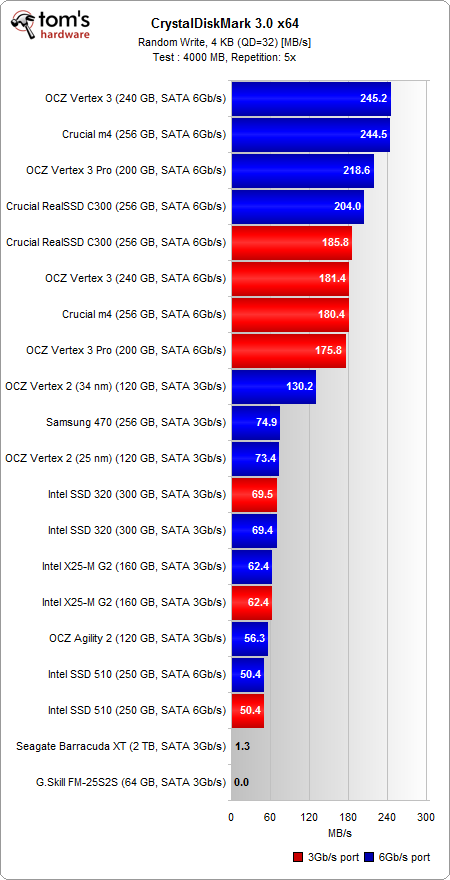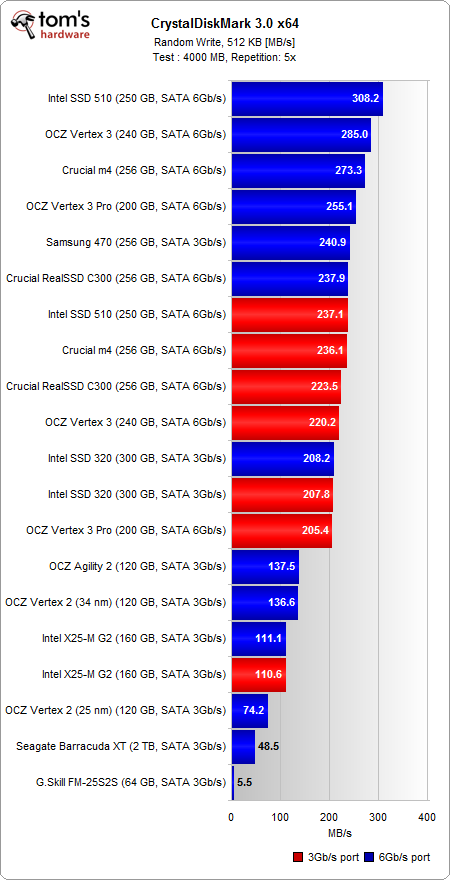Crucial m4 And Intel SSD 320: The Other SSD Competitors
Benchmark Results: 4 KB And 512 KB Random Writes
Remember that our benchmark tends to give more weight to burst performance. By default, the Vertex 3s push IOPS above 50 000 thanks to its compression technology. In comparison, the m4 performs slightly above 60 000 IOPS, a marked improvement from the C300.
Interestingly, the X25-M again chokes at queue depths in excess of eight. Intel corrects this problem in the SSD 320. We no longer see a performance penalty at higher queue depths.
Low queue depths are not necessarily ideal for SSDs, which depend on many pending requests in order to saturate their parallelized architectures. In this scenario, the m4 starts off more competitive. At a queue depth of one, it already outperforms the earlier C300. Once we reach a queue depth of 32, Crucial's newest drive even outperforms OCZ's Vertex 3 Pro.
Intel's SSD 320 performs close to the X25-M at lower queue depths. As we scale up to 32, we see close to a 10% improvement in throughput.
This is a major turnaround for the SSD 510. Intel's only SATA 6Gb/s drive is clearly optimized for moving larger files. Though it struggles with 4 KB transfers, 512 KB transfers excel, and the SSD 510 turns a last-place finish into a first-place finish, even trumping the Vertex 3 drives.
Crucial's m4 takes a more even-handed approach. It performs well in 4 KB and 512 KB transfers. More impressive, it consistently outperforms the beta sample of OCZ's Vertex 3 Pro. The SSD 320 also turns in much better performance. This time, it shows a 50% improvement over the X25-M.
If you own an older SSD, notice how far behind the first-generation of OCZ's SandForce drives fall.
Get Tom's Hardware's best news and in-depth reviews, straight to your inbox.
Current page: Benchmark Results: 4 KB And 512 KB Random Writes
Prev Page Benchmark Results: 4 KB And 512 KB Random Reads Next Page Benchmark Results: PCMark Vantage Storage Test-
Could you expand on the Full Disk Encryption capabilities of the Intel 320?Reply
If you can actually use hardware FDE on that drive (rather than just secure erase), that's a winner for me. -
bto Why does the Intel 510 250GB appear to have two scores in crystalmark? (469.4 and 259.7) on the top benchmark on page: "Benchmark Results: CrystalDiskMark Streaming Performance" the specs are identical for both.Reply -
poppasmurf Great lil tidbit, wonder what the difference will be between other SSD's with different interface connections other than physical appearance and the interface connection. More on the lines of pro's and con's between the SSD interface connections I'm referring to the OCZ PCI-e drives vs. SATA 6GB just a thought to stir up the hoop la of ssd's :PReply -
JohnnyLucky I am beginning to wonder if we haven't reached the point where the human eye and brain are finding it harder to differentiate performance among ssd's. Some mainstream benchmarks seem to suggest that. Some of the benchmarks in this review seem to indicate the same. There are some very tight groupings.Reply -
henryvalz At the speed points that SSDs are functioning, I'm beginning to think that durability and reliability might be the best basis for decision. I would also really like to see some boot times from Windows 7, or loading time for games.Reply -
kev_stev Does anyone know when the vertex 3 and M4 are going to actually be available? I have heard rumors that the vertex 3 will be released "any day now" since mid march...Reply -
iamtheking123 I'll go SSD in my next build, probably in a year and a half. Right now I'm satisfied with Raid 0-ed 1TB Caviar Blacks.Reply



